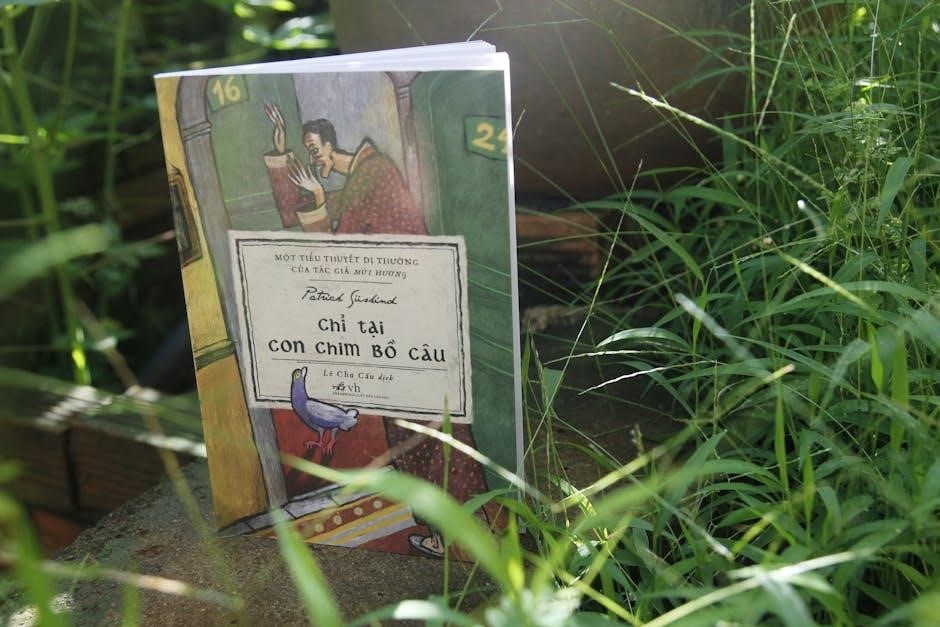
one hundred years of solitude novel pdf
Published in 1967, One Hundred Years of Solitude by Gabriel García Márquez is a seminal work of magical realism, chronicling the rise and fall of Macondo and the Buendía family, blending fantasy and history in a captivating narrative that has become a cornerstone of world literature.

Background on Gabriel García Márquez
Gabriel García Márquez, a Nobel Prize-winning Colombian author, was born on March 6, 1927, in Aracataca, Colombia. His writing is deeply rooted in Colombian culture and history, blending realism with magical elements. Known as the father of magical realism, García Márquez drew inspiration from his childhood, family stories, and the political turmoil of Latin America. Before becoming a renowned novelist, he worked as a journalist and screenwriter. His most famous works include One Hundred Years of Solitude and Love in the Time of Cholera. García Márquez’s unique narrative style and exploration of human emotions earned him global acclaim. He passed away on April 17, 2014, leaving behind a legacy as one of the most influential writers of the 20th century.
Overview of the Novel
One Hundred Years of Solitude is a captivating tale that follows the Buendía family and their fictional town, Macondo, through generations. The novel masterfully intertwines magical realism with historical and cultural elements, creating a rich tapestry of stories. From the town’s founding by José Arcadio Buendía to its eventual decline, the narrative explores themes of love, solitude, and the cyclical nature of time. The Buendías’ struggles with destiny, family curses, and personal ambitions are central to the plot. García Márquez’s unique prose weaves together the extraordinary and the mundane, making Macondo a symbol of both isolation and universality. This iconic novel has become a cornerstone of Latin American literature, resonating with readers worldwide for its profound insight into the human condition and the passage of time.

Plot Summary
One Hundred Years of Solitude traces the rise and fall of Macondo and the Buendía family, exploring themes of solitude, destiny, and the cyclical nature of time through magical realism.
The Founding of Macondo
The founding of Macondo is rooted in the visionary dream of José Arcadio Buendía, who, along with his wife Úrsula Iguarán, sought to establish a new home. While sleeping on a riverbank, José Arcadio envisioned Macondo as a city of mirrors, inspiring him to settle there. The town’s creation marked the beginning of a unique and isolated community, characterized by its enchanting and enigmatic nature. This foundational event sets the stage for the Buendía family’s intricate history and the town’s eventual rise to prominence.
Key Events in the Novel
The novel unfolds through a series of pivotal events that shape the destiny of Macondo and the Buendía family. The town’s rise is marked by the arrival of gypsies, who introduce mystical elements and spark curiosity. A significant event is the insomnia plague, which erases memories and leads to the decline of individual and collective identity. Melquiades, the mysterious gypsy, plays a crucial role by foreseeing the town’s fate through his prophecies. The Buendías’ struggles with love, solitude, and repetition are central, as seen in the tragic tales of characters like Colonel Aureliano Buendía, who fights quixotic wars, and the recurring fate of José Arcadio. These events weave a tapestry of magic and reality, illustrating the cyclical nature of time and the inevitable downfall of Macondo.

The Decline of Macondo
The decline of Macondo is a gradual and inevitable process, mirroring the fate of the Buendía family. As the town’s isolation deepens, it becomes vulnerable to external forces and internal decay. The once-thriving community is plagued by political turmoil, economic downturn, and the loss of its founding ideals. The arrival of foreign corporations and the exploitation of natural resources mark the beginning of Macondo’s downfall. Simultaneously, the Buendías face personal crises, including madness, solitude, and a cyclical repetition of their ancestors’ mistakes. The novel ends with Macondo’s destruction in a final cataclysmic event, symbolizing the end of an era and the fulfillment of Melquiades’ prophecies. This decline underscores themes of fate, repetition, and the inescapable passage of time.

Characters
The Buendía family, central to the novel, encompasses a rich tapestry of characters, each with unique traits that shape Macondo’s destiny through love, solitude, and struggle.
The Buendía Family Tree
The Buendía family tree is central to the novel, tracing the lineage from founders José Arcadio Buendía and Úrsula Iguarán through multiple generations. Their children, including José Arcadio, Aureliano, and Amaranta, begin a cycle of repetition in names and destinies. Each generation faces similar struggles, with characters often mirroring their ancestors’ fates. The family’s history is marked by both brilliance and tragedy, as seen in figures like Colonel Aureliano Buendía, who becomes a revolutionary leader, and Úrsula, whose longevity binds the family together. The recurring names reflect themes of fate and inescapable destiny, creating a sense of timelessness and inevitability that defines Macondo’s history. The intricate web of relationships and shared traits underscores the novel’s exploration of human nature and cyclical time.
Major Character Analyses
José Arcadio Buendía, the patriarch, represents curiosity and innovation, driving Macondo’s early prosperity through his inventions. His wife, Úrsula Iguarán, embodies resilience and practicality, serving as the emotional anchor of the family. Colonel Aureliano Buendía, their son, is a tragic figure, symbolizing idealism and the futility of political endeavors. His obsession with revolution highlights the cyclical nature of time and the inevitability of defeat. Other notable characters include Melquíades, the enigmatic gypsy whose prophecies shape the town’s destiny, and Rebeca, whose mysterious past and isolation reflect the novel’s themes of solitude. Each character’s unique traits and struggles contribute to the rich tapestry of the Buendía family’s history, illustrating the interplay of fate and human emotion in the face of an inescapable destiny.
Recurring Character Archetypes
The novel features recurring archetypes that reflect the cyclical nature of time and human experience. The inventive, visionary figures like José Arcadio Buendía embody curiosity and progress, while the pragmatic, grounding presence of Úrsula Iguarán symbolizes stability and tradition. Military leaders, such as Colonel Aureliano Buendía, represent idealism and the futility of political struggle. The solitary, introspective characters, like Rebeca and Amaranta Úrsula, illustrate the profound isolation that permeates the Buendía family’s history. These archetypes, repeating across generations, underscore the inevitability of fate and the repetition of experiences. Each archetype serves as a metaphor for universal human struggles, such as the pursuit of knowledge, the quest for love, and the inexorable passage of time, enriching the novel’s exploration of solitude and destiny.

Themes
Central themes include isolation, family destiny, and the cyclical nature of time, intertwined with Colombian history and magical realism, reflecting universal human experiences through reality and fantasy.
Love and Solitude
Love and solitude are deeply intertwined in One Hundred Years of Solitude, often manifesting as unrequited passion and existential isolation. Characters like Fermina Daza and Florentino Ariza embody this duality, with their love spanning decades yet remaining unconsummated. The novel portrays love as both a transcendent force and a source of relentless suffering. Solitude, meanwhile, is not just the absence of connection but a profound state of being, as seen in Colonel Aureliano Buendía’s lonely pursuit of meaning. García Márquez explores how love often leads to isolation, whether through rejection, obsession, or the inability to connect. This theme underscores the human condition, where even the most intense emotions can result in profound loneliness, highlighting the intricate and often tragic interplay between love and solitude.
Fate vs. Free Will
The tension between fate and free will is a central theme in One Hundred Years of Solitude. The Buendía family is cursed with a predetermined destiny, as foreseen by Melquiades’ prophecies, suggesting an inevitability to their actions. Yet, characters like Colonel Aureliano Buendía and José Arcadio II make choices that shape their lives, illustrating the interplay between fate and personal agency. The novel suggests that while fate sets the stage, individuals still exercise free will, even if their decisions lead to predictable outcomes. This duality underscores the tragic inevitability of the Buendías’ decline, blending the notion of destiny with the human capacity for self-determination. García Márquez thus explores the complex relationship between the forces of fate and the choices that define human existence.

The Passage of Time
The passage of time in One Hundred Years of Solitude is depicted as cyclical and relentless, creating a sense of inevitability and repetition. The novel spans multiple generations of the Buendía family, with time compressing and expanding in non-linear ways. This non-traditional timeline reflects the fluidity of memory and the collective experience of Macondo’s inhabitants. The town’s rise and fall mirror the passage of time, as does the gradual decline of the Buendía family. García Márquez uses time to explore themes of aging, memory, and the inevitability of decay, blending the personal and historical to create a universal narrative. The novel’s unique handling of temporality underscores the interconnectedness of past, present, and future, leaving a lasting impression on the reader.

Symbolism
Symbolism in the novel includes the gypsies introducing magic, the insomnia plague causing memory loss, and Melquiades’ prophecies reflecting fate and cyclical time.
The Gypsies and Their Role
The gypsies in One Hundred Years of Solitude serve as mystical catalysts, introducing the Buendía family to magical and scientific wonders. They arrive periodically, bringing innovation and prophecy, while their departures signal loss and decline. Melquiades, their enigmatic leader, plays a central role in shaping Macondo’s destiny through his prophecies and writings. The gypsies’ presence symbolizes the external forces that influence the town’s fate, blending reality with the supernatural. Their visits spark curiosity and transformation, yet their absence plunges Macondo into isolation and stagnation. Through their interactions, the gypsies embody the cyclical nature of time and the inevitable intertwining of progress and decay.
The Insomnia Plague
The Insomnia Plague is a mysterious affliction that sweeps through Macondo, causing its inhabitants to lose their memory gradually. Initially, the townspeople forget minor details, but the condition worsens, erasing even the most basic knowledge of everyday objects and their uses. In response, the Buendías label household items and write reminders to maintain order. The plague symbolizes the fragility of human memory and the disintegration of societal structures. It also underscores the cyclical nature of time, as the town’s collective identity unravels. The plague ultimately isolates individuals, leaving them disconnected from their past and unable to form meaningful connections. This surreal event exemplifies García Márquez’s use of magical realism to explore universal human struggles and the inevitable decline of Macondo.
Melquiades’ Prophecies
Melquiades, the enigmatic gypsy, plays a pivotal role in One Hundred Years of Solitude through his prophetic interventions. His periodic visits to Macondo bring revelations about the town’s destiny and the Buendía family’s fate. Melquiades’ prophecies, inscribed on parchments, foresee events such as the arrival of modernity, the rise of authoritarianism, and the inevitable decline of Macondo. His predictions are cryptic yet precise, guiding characters like Colonel Aureliano Buendía in their pursuits. The prophecies also serve as a narrative device, weaving together the novel’s cyclical structure and reinforcing the theme of inescapable destiny. Melquiades’ wisdom and foresight create a sense of inevitability, highlighting the interplay between fate and human agency in the lives of the Buendías and the doomed town they founded.
Style and Structure
Gabriel García Márquez’s One Hundred Years of Solitude employs a unique narrative structure, blending magical realism with a cyclical timeline, creating a timeless yet intricate storytelling experience.
Magic Realism
Gabriel García Márquez’s One Hundred Years of Solitude is a quintessential example of magic realism, a literary style that seamlessly integrates fantastical elements into everyday life. In Macondo, the supernatural becomes mundane, as if it were an ordinary part of reality. For instance, characters like Melquíades, a gypsy with prophetic abilities, or Remedios Buendía, who ascends to heaven, are portrayed with the same matter-of-factness as more conventional events. This blending of the extraordinary and the ordinary creates a unique narrative voice that captivates readers. García Márquez uses this style to explore deeper truths about human nature, history, and fate, making the fantastical elements serve a thematic purpose rather than mere embellishment. The result is a captivating and thought-provoking story that challenges readers’ perceptions of reality and fiction.
Narrative Techniques
Gabriel García Márquez employs a range of innovative narrative techniques in One Hundred Years of Solitude to create a unique storytelling experience. The novel features a cyclical structure, where time folds in on itself, blurring past, present, and future. This is reinforced by the repetition of names and events across generations, emphasizing the inevitability of fate. The narrator often jumps between timelines, creating a sense of timelessness. Additionally, García Márquez uses prophecy and foreshadowing, such as Melquíades’ gypsy predictions, to weave a sense of destiny throughout the story. The narrative voice is omniscient yet intimate, blending collective and individual perspectives seamlessly. These techniques not only reflect the novel’s themes of fate and interconnectedness but also immerse readers in the mystical world of Macondo, making the story both captivating and deeply layered.
Historical Context
One Hundred Years of Solitude reflects Colombian history, spanning the early 1800s to 1900s, blending fictional and real events to capture the nation’s cultural and political essence.
Colombian History
One Hundred Years of Solitude mirrors Colombia’s historical trajectory, from the nation’s struggle for independence to the turmoil of civil wars and foreign interventions. The novel’s fictional town of Macondo serves as a microcosm of Colombian society, reflecting the nation’s cultural identity and political upheavals. The Buendía family’s experiences are intertwined with the broader historical events of the 19th and early 20th centuries, such as colonial resistance, modernization efforts, and the rise of capitalism. García Márquez weaves real historical events with fictional narratives, creating a rich tapestry that captures the essence of Colombia’s past. The cyclical nature of time in the novel also reflects the repetitive patterns of Colombian history, where progress is often overshadowed by recurring cycles of violence and isolation.
Latin American Experience
One Hundred Years of Solitude is deeply rooted in the collective identity of Latin America, capturing its unique cultural, historical, and emotional essence. The novel reflects the region’s struggles with colonialism, independence, and modernization, as well as its rich tapestry of myths, superstitions, and traditions. Through the isolated town of Macondo, García Márquez portrays the universal themes of love, solitude, and the cyclical nature of time, which resonate across Latin American societies. The Buendía family’s journey mirrors the region’s history of resilience and transformation, blending the fantastical with the real to create a timeless narrative. The novel’s exploration of identity, isolation, and the human condition underscores the shared experiences of Latin America, making it a defining work of its literary tradition.

Reception
One Hundred Years of Solitude received widespread critical acclaim, hailed as a landmark of magical realism. Its unique narrative and timeless themes solidified its status as a literary classic.
Critical Acclaim
One Hundred Years of Solitude has garnered universal praise for its innovative storytelling and rich thematic depth. Critics celebrate its seamless blend of fantasy and historical reality, dubbing it a masterpiece of magical realism. The novel’s intricate narrative structure and vivid characterization have been widely admired, with many hailing it as a defining work of 20th-century literature. Its exploration of themes such as solitude, time, and human destiny resonates deeply with readers. The book’s influence extends beyond literature, shaping cultural and academic discourse. García Márquez’s prose is often described as lyrical and evocative, immersing readers in the mystical world of Macondo. This acclaim led to García Márquez winning the Nobel Prize in Literature in 1982, cementing the novel’s legacy as a literary icon.
Cultural Impact
One Hundred Years of Solitude has left an indelible mark on global culture, transcending literature to influence film, art, and music. Its unique narrative style and magical realism have inspired countless adaptations and creative works. The novel’s themes of solitude, time, and destiny resonate universally, making it a cultural touchstone. In Latin America, it has fostered pride in regional identity, while its exploration of history and mythology has sparked broader conversations about colonialism and cultural heritage. Educational institutions worldwide include it in curriculums, introducing new generations to its richness. The book’s influence extends to popular culture, with references in media, music, and even philosophy. Its legacy as a cultural icon continues to grow, cementing its place as a defining work of the 20th century and beyond.

Analysis
The novel’s cyclical narrative explores the interconnectedness of time, where past, present, and future converge, illuminating the inevitable repetition of fate and the decline of Macondo.
Cyclical Nature of Time
The novel’s portrayal of time is uniquely cyclical, where events repeat across generations, creating a sense of inevitability and fate. This structure reflects the Buendía family’s experiences, as their fortunes rise and fall in a predictable pattern. The cyclical nature of time is emphasized through the recurring names and destinies of characters, such as the multiple José Arcadios and Aurelianos, who face similar challenges and outcomes. This cyclical narrative underscores the futility of attempting to escape one’s destiny, as the characters are bound by the repetitive flow of time. The cyclical nature of time also mirrors the rise and decline of Macondo, symbolizing the universal human experience of birth, growth, decay, and renewal. Through this, García Márquez explores the interplay between fate and free will, leaving readers to ponder the inevitability of their own destinies.
Legacy of the Novel
One Hundred Years of Solitude has left an indelible mark on world literature, solidifying Gabriel García Márquez’s status as a literary giant. Its unique blend of magical realism has influenced countless authors and works, reshaping the way stories are told. The novel’s exploration of themes such as love, solitude, and the cyclical nature of time continues to resonate with readers globally. Its cultural impact extends beyond literature, inspiring adaptations in film, art, and music. As a seminal work, it remains a cornerstone of academic study, offering profound insights into the human condition. The novel’s enduring popularity ensures its place as a timeless classic, continuing to captivate audiences with its rich, intricate narrative and universal themes. Its legacy is a testament to the power of storytelling to transcend time and culture.
One Hundred Years of Solitude remains a masterpiece of world literature, offering a profound exploration of human existence through the lens of the Buendía family and the mystical town of Macondo. Gabriel García Márquez’s innovative use of magical realism has redefined storytelling, blending the fantastical with the everyday to create a universally relatable narrative. The novel’s intricate web of love, solitude, and the inexorable passage of time continues to captivate readers, inviting them to reflect on their own lives and the cyclical nature of history. Its influence extends beyond literature, shaping cultural and intellectual discourse. As a work of enduring beauty and depth, One Hundred Years of Solitude ensures that Macondo and its inhabitants will forever hold a place in the imagination of readers worldwide.